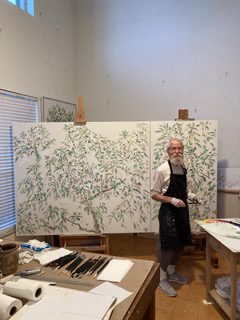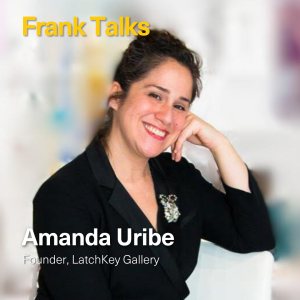Bjorklund was born in Sheridan, Wyoming in 1938 and grew up in Southern California, where he received his BA in Comparative Literature and MFA in Graphic Art from the University of Southern California. In 1959 he moved to Aix-en-Provence, France, where he met master German painter Leo Marchutz and served as his apprentice and associate for 15 years. With Marchutz, and artist William Weyman, Bjorklund co-founded the Leo Marchutz School of Painting & Drawing in 1972, where he taught until 1984. He was awarded the Oskar Kokoschka City of Salzburg Prize in 1961 and was honored with Lifetime Achievement in the Arts by the Institute for American Universities in Aix-en Provence in 2017. He has exhibited across Europe and the US at galleries La Muraille in Besancon, France, and Gallery Etienne de Causans, Paris and at the Grand Prix of Monte Carlo, and the Biennale Internationale d’Aix-en-Provence as well as the Reynolds Gallery in Richmond Virginia. His paintings are included in private and museum collections in Europe and America. Bjorklund resided in France, Antigua (W.I.), and the Dominican Republic until 2005. He currently lives and works in Florida.
Tell us a little more about yourself. When did you realize you wanted to pursue a career in this industry?
In the biggest sense of the word, my life began in 1959 when I met Leo Marchutz. I came to Aix -en-Provence for my junior year abroad at the Institute For American Universities from the University of Southern California where I was majoring in Comp. Lit. and had little thought of becoming a painter. I joined Leo’s painting class out of curiosity and stayed on to work with him until his death in 1976. Meanwhile another returning student, Billy Weyman, came back to also continue working with Leo. We started the LMS in 1972 with encouragement from two assistant directors at the Institute to resolve ongoing tension between our art classes and the administration. When Leo passed in 1976 questions arose as to whether the school should or could continue without Leo. There was enough momentum to carry us to this point some 50 years later.
Every day of my 60 plus years as an artist I become more aware of how sound and profound a base I received from Leo and Kokoschka. And I remain impressed with how well the messages have been received and perpetuated by the succeeding generation. I guess it was more serendipity that got me to Aix and Leo.
Where are you from and what is the arts community like there? How has your upbringing shaped what you do in the arts today?
I was raised in Southern California, and frankly my focus was on the ocean. As a young child (grammar school) I drew a lot at home after school. In college I took a couple ‘Art Appreciation’ classes, and spent a fair amount of time in the Los Angeles County museum. But nothing in my environment really encouraged or even pointed in the direction of the arts. Money and material concerns were more important.
What was your first job? What is a lesson from that experience that you’ve carried with you?
I had, like most kids back then, a paper route. Riding around on my bicycle throwing folded papers onto front porches, usually with a barking dog pursuing me – until I started bringing my English Bull Terrier with me. He put an end to the chasing dogs. In high school I worked in construction, and as a waiter in the school dining hall. In college I had a job curating and matting a large collection of modern Japanese woodcuts for a private collection. Next came a stint in the Merchant Marine which took me throughout Asia.
By the time I returned to Aix-en-Provence, (this time with a wife and child)I had learned enough lithography (master’s degree) that I started printing editions for other artists, as well as teaching a lithography class. In 1972 with the founding of the Marchutz School I began teaching painting and drawing.
As for lessons learned through that progression of jobs I think the most important part was the influence of Asian art as well as Spirituality. I remain much closer to Buddhist thought than western Judeo/Christian thought. And the art of Asia gave me a propensity for improvisation and spontaneity. Well, my reflections on Asian drawing coupled with my love of Jazz.
You are a co-founder of the Leo Marchutz School of Painting & Drawing. Tell us more about Marchutz and how it came to be!
Leo Marchutz was a German born self taught artist who came to Aix-en-Provence in 1928 drawn to the home of the artist he most admired, Paul Cezanne. He had gained some attention as a child painting large religious compositions in his parents’ house and in 1919 the purchase of Leo’s large ‘Ascension’ painting by the famous theatre director Max Reinhardt, who wrote praising the young 16 year old artist, helped persuade his parents to let him study art.
The parents wanted him to submit to formal art education, but everywhere he looked he saw nothing that inspired him to want to learn there. Instead, he chose to use the museums (and zoo) for his studies. In the museums he patiently searched for the common factors that could be found in the true masters and tried to develop those traits in his own work. In 1921 he had an important encouragement: Karl Ernst Osthaus, the founder of the famous Folkwang Museum in Essen, gave Marchutz his first one man show. At only 18 years of age the die was cast.
He traveled throughout Italy to see the great masterpieces at first hand, as well as to look at the Antiquities from Pompey among others. In 1924 he drew a series of drawings inspired by Plato’s Symposium from which he produced his first book of Lithographs; Plato’s Symposium. These figures and heads show how very much he learned from the ancient sculpture and Greek plasters and carry in them the hint of the refined and pure figures that were to appear in his St. Luke 20 years later. If anyone would like to read further about our founding of the LMS, my co-founder, Billy Weyman has written an interesting account of those years that is available on Amazon. It is called; Leo and I and the Ghost of Cezanne.
What does an average day look like for you in the studio?
I am not an early riser, but once I get going, it is pretty much the same routine; Eat breakfast, take care of the dogs, do a meditation and into the studio. I do not go to the studio without a meditation first. This reminds me to stay out of my head and into my heart and the present moment. I am working on rather larger paintings these days, so there is usually something on the easel awaiting me. I work until the natural light fades in the evening.
What is something you do every day to keep you motivated?
Exercise, meditate, pray and show up in the studio.
What is the best piece of advice you can give about pursuing a career in art?
Everyone will have a different path into the art world. Patience, perseverance, motivation. Balance the three. Learn to stand on the shoulders of the greats, do not worry about fame but rather the truth and purity of the work at hand. Try to stay in the line.
For Artists: The motif has its demands, the canvas has its demands, and my vision has its demands. This equals a balancing act on your part. Seek to develop your ability to see into nature with more than your eyes. As your sight becomes more creative and deepens (insight) you will find that the technique to render that vision will develop in a way that grows out of it, not something into which you try to fit it. The most important advice I got from Leo was this; “Do not think when you are painting”. Save thinking for between sessions.
What are you most excited for this year in the Marchutz community or in the art world as a whole?
In this moment the Marchutz community has a number of exciting activities. A Catalogue Raisonee, presentations in Nuremberg of Leo’s work, as well as all the museum visits and school sessions that are being offered in varied locations.
If you could own work by 5 different artists/craftspeople, who would be in your collection?
No-one is going to give me a Rembrandt, Titien, Van Gogh, Guardi or Turner, so I will continue enjoying the works I already have; Marchutz, Weyman, DeAsis, and yes, Whistler, Giacometti and Berthe Morisot.




